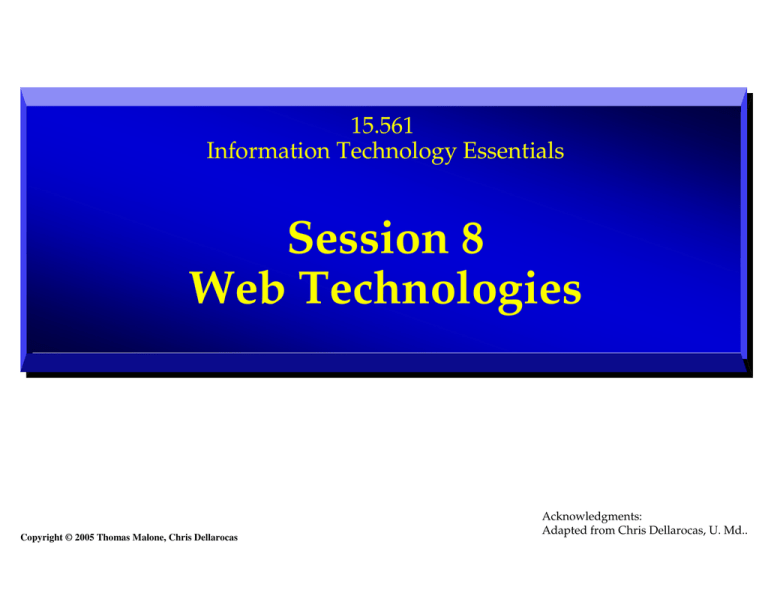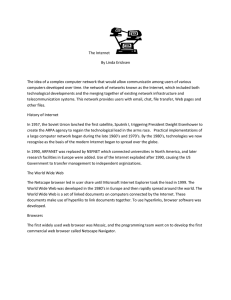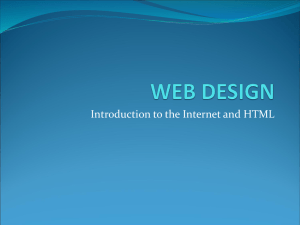Document 13616792
advertisement

15.561
Information Technology Essentials
Session 8
Web Technologies
Copyright © 2005 Thomas Malone, Chris Dellarocas
Acknowledgments:
Adapted from Chris Dellarocas, U. Md..
World-Wide-Web
or The Triumph of Anarchy
• Perhaps the most important human technological artifact that
evolved more or less ad-hoc
• Limited original vision of the WWW has very little to do with
today’s impressive reality
• Web Users have consistently innovated in figuring out new
ways of leveraging this powerful medium
• Web architects then try to catch up by extending (read
“patching”) the Web infrastructure to support these new uses
How it all started…
The Web as a Static Document Repository
• Tim Berners-Lee’s original vision for the WWW (circa 1989)
• An easy way to access cross-linked static documents stored
in a variety of servers around the world
• Initial specification defined:
– A language for formatting such documents (HTML)
– A simple protocol for communicating between browsers and servers (HTTP)
The turning point
1993 - Marc Andreesen (student at UIUC) writes Mosaic –
first graphical WWW browser
(precursor of Netscape)
How the (original) Web works
Open Location: http://webmit.
. edu/sl
oan/www/index
.
html
v
Webserer
I
nter
net
Webcl
ient
I
x or
,
nter
net Epl
er
(
,Netscape,etc.
)
ir
ef
ox
F
Domain Name Serer
v
Anatomy of a URL
URL =Unif
or
m Resouce
r
Locator
http://webmit.
. edu/sl
oan/www/index
.
html
Name ofpr
otocol
f
orcommunication
v
with serer
(
http is standar
dweb
pr
otocol
)
Domain name ofweb
serer
v wher
e page is
stor
ed
fe
Pathname ofil
within webserer
v ‘s
l
ocalil
fe sy
stem
How the Web works
Open Location: http://webmit.
. edu/sl
oan/www/index
.
html
18.
30.
0.
22
Look
ingup host:
web.
mit.
edu.
.
.
Webser
v
er
What is the
I
Paddr
ess of
web.
mit.
edu?
I
nter
net
Webcl
ient
I
nter
net Ex
pl
or
er
,
(
ir
ef
ox
,Netscape,etc.
)
F
Domain Name Ser
v
er
How the Web works
Open Location: http://webmit.
. edu/sl
oan/www/index
.
html
Her
e it is
Contactinghost:
web.
mit.
edu.
.
.
Webser
v
er
I
nter
net
Pl
ease sendme f
il
e
/sl
oan/www/index
.
html
Webcl
ient
I
nter
net Ex
pl
or
er
,
(
ir
ef
ox
,Netscape,etc.
)
F
Domain Name Ser
v
er
How the Web works
Open Location: http://webmit.
. edu/sl
oan/www/index
.
html
Contactinghost:
web.
mit.
edu.
.
.
v
Webserer
I
nter
net
Webcl
ient
nter
net Epl
er
(
I
x or
,
ef
ox
Fir
,Netscape,etc.
)
Domain Name Serer
v
WWW is a Client/Server System
• Web Clients
– Use HTTP protocol to connect to servers
– Request and display Web pages stored in servers
– Typical clients: Web browsers
• Web Servers
– Listen for incoming connections from clients
– Use HTTP protocol to converse with clients
– Store and transmit Web pages to clients
Summary: WWW The Original Concept
(1989-1995)
• Human Readers · ‚ Interconnected Static Documents
• Main advantage:
– Universality
• Main disadvantage
– Lack of interactivity
– Yet another mass broadcast medium
• Main business use
– Awareness building
Evolution of the WWW
Business Drivers
• Enable transactions
• Allow interactivity between browser and server
• Facilitate personalization
• Support multiple browsing devices
• Better organize and retrieve Web content
• Support Business-to-Business applications
The Web as a transaction facilitator
• Business Motivation: Low-cost front-end for allowing
customers to connect to corporate computers
– Customer registration/Address changes
– Order tracking/Customer support
– Online Transactions: eCommerce
• Problems of original Web concept
–
–
–
–
Static web pages
No interactivity
Stateless protocol: no support for multi-step transactions
Insecure communications
Web Forms
• Pages which contain fields to be filled by user
• Usually contain a “Submit” button
• When user presses “Submit”, server responds by
sending a page containing information specific to the
user-supplied parameters
• Examples:
– Web search tools
– Order forms in commercial web sites
Web Forms Under the Hood
• Server sends original html page containing input fields
• User types info into fields and presses submit button
• Client establishes connection with handler script at server
side (script filename contained in web page)
• Client collects user input into a long string and sends it
along with an HTTP command back to server
– POST customer=John+Doe&cardno=1234567890&expires=6/98&
product=123&quantity=5
• Handler script at server reads parameter string and
processes it, usually producing a new page as a result
CGI
• Common Gateway Interface
• Set of standards for writing handler scripts
• How it works
– All URLs that refer to a special directory (e.g. /cgi) cause the
execution of a corresponding script at the server (for example
http://web.mit.edu/cgi/test)
– Scripts typically translate parameters into SQL statements for a
database and translate the query results into an HTML page
Example: FedEx
Translate airbill number into query
as expected by legacy system
Server
software
Custom
script
Package results returned by legacy
system into a Web page
Webbr
owser
I
nter
net
Webser
v
er
Database
Legacy
sy
stem
Microsoft Active Server Pages (ASP)
• Competing technology to CGI
– Scripting Language is similar to Visual Basic
• MS Access can automatically convert database tables,
queries and forms into ASP pages
• Requires Microsoft web server
Evolution of the WWW
Business Drivers
• Enable transactions
• Allow interactivity between browser and server
• Facilitate personalization
• Support multiple browsing devices
• Better organize and retrieve Web content
• Support Business-to-Business applications
The Interactive Web
• Business Motivation:
– Allow complex interaction between user browser and corporate
server
– Web becomes an extension of the user’s PC
– Browser becomes a window to a variety of corporate applications
• Problems with Web Forms/CGI/ASP
– All processing done at server side
– Rapid user interaction with Web page not possible
– Need local processing to create highly interactive Web pages
Enter Java Applets
• Programming language to enable interactive Web
pages
• Developed by Sun Microsystems
– originally for programming intelligent microwave ovens!!!
• Java programs are called applets
• Applets are platform-independent
– They can run equally well on Windows, Macs, Unix, etc.
– Require special browsers that can support Java though
Java Operation
Servers
S
Internet
Sun/UNIX
Windows XP
Mac OS
D
J
• Static pages (S)
• Dynamic pages (D)
• Java applets (J)
Mac OS
HTML
page
Java
applet
HTML
page
Java
applet
HMTL
Interpreter
Java
interpreter
HMTL
Interpreter
Java
interpreter
Netscape (Win XP)
Netscape (Mac OS)
Windows XP
Mac OS
PC Hardware
PowerMac Hardware
Client environments
}
same
}
different
Adapted from Stuart Madnick, MIT
Evolution of the WWW
Business Drivers
• Enable transactions
• Allow interactivity between browser and server
• Facilitate personalization
• Support multiple browsing devices
• Better organize and retrieve Web content
• Support Business-to-Business applications
Personalized Interaction
• Business motivation:
– Low cost medium for gathering information from customers to
allow
» Personalized service
» Targeted advertising
• Problems with current model
– Does not allow easy identification of distinct customers
Cookies
• A method for identifying web users and delivering
customized web sites
– First time user connects to a web site, s/he is asked to fill in personal
information form
– Server packages information into a “cookie” file and sends cookie
to browser
– Browser stores cookie in local file system
– Each subsequent time browser visits site, it sends cookie back to
server
– Server uses information stored in cookie to identify user and
possibly customize the supplied web pages
• Privacy implications?
Cookie applications
SERVER
BROWSER/CLIENT
GET: server.com/dynamic.app?
USER=0xx32
COOKIE
0xx32
1ab16
Age = 24
1ab16
Name1 = Matt
1ab16
Name2 = Lane
0xx32 Age = 35
0xx32 Name1 = Jane
0xx32 Name2 = Doe
Jane Doe
Widget1 is just right for you.
Widget2 is just right for you.
CLIENT
TYPE: text/html
<HTML>
�
<BODY>
�
�
<P>Jane Doe</P>
<P><font COLOR="#FF0000">
�
Widget1</font>
is just right for you</P>
<P><font COLOR="#FF0000">
�
Widget2</font>
is just right for you</P>
�
</BODY>
<?HTML>
NETWORK
2bc61
Age = 55
2bc61
Name1 = Sam
2bc61
Name2 = Paul
output<Name>;
while (get.next.product())
{
output "<PRODUCT>
is just right for you";
}
Product
ODBC
SERVER
Widget0
MKT
18-24
Widget1
Widget2
25-40
25-40
Widget3
18-24
Widget4
41-60
Widget5
41-60
The user's browser passes the contents of the cookie to the Web server. The server uses this cookie to look up information
about the user (this information may have been gained from a previous registration process). The information (specifically,
the user's age) is used to query a database via ODBC to determine which products should be recommended to this user. The
resulting list of products is inserted into a dynamically created HTML page and sent to the user's browser for display.
Figure by MIT OCW.
Summary: WWW The Current Concept
(1995-today)
• Human Users · ‚ Documents and Applications
• Main business use
– B2C Transactions
– Customer Support
Evolution of the WWW
Business Drivers
• Enable transactions
• Allow interactivity between browser and server
• Facilitate personalization
• Support multiple browsing devices
• Better organize and retrieve Web content
• Support Business-to-Business applications
Multiple Delivery Devices
• Business motivation:
– Allow users to access web content from a variety of devices
» PC Browsers
» PDAs (e.g. Palm Pilots)
» Mobile Phones
» Telephones (via voice interface)
» …
• Problems of current Web model
– Each access device has different look-and-feel requirements
– HTML specifies formatting for PC browsers only
Organize and Index Web Content
• Web is useless unless we can easily locate relevant
resources
• Current solution: Search Engines
– Index the Web by automatically “discovering” web pages and
organizing them around keywords found in their text
How does Google work?
• Before you ever enter a query:
– Programs (called “web crawlers” or “spiders”)
follow links from one page to another all over the
web.
– The programs construct indexes of which words
appear on which pages and save the indexes (and
often copies of the pages) on massive “server
farms” maintained by Google.
– Each page is also assigned a “page rank” based on
the number of other pages that link to it. Links
from pages that, in turn, have lots of other pages
linking to them are weighted more heavily.
Google’s page rank formula
• PR(A) = (1-d) + d(PR(t1)/C(t1) + ... + PR(tn)/C(tn))
– Where
» t1 - tn are pages linking to page A,
» C is the number of outbound links that a page has
» d is a damping factor, usually set to 0.85.
• In words:
– a page'
s PageRank = 0.15 + 0.85 * (a "share" of the PageRank
of every page that links to it)
– "share" = the linking page'
s PageRank divided by the number
of outbound links on the page.
How does Google work? (cont.)
• After you enter a query:
– Programs check the indexes to determine which
pages contain the combination of words you
entered.
– Google provides a list of these pages in order of
page rank (order is probably affected by other
factors, too)
Google numbers
(as of December 2004)
• Over four billion Web pages, each an average of 10KB, all fully indexed.
• Up to 2,000 PCs in a cluster.
• Over 30 clusters.
• One petabyte of data in a cluster -- so much that hard disk error rates of 10-15
begin to be a real issue.
• Sustained transfer rates of 2Gbps in a cluster.
• An expectation that two machines will fail every day in each of the larger
clusters.
• No complete system failure since February 2000.
Source: ZDNet – UK <http://www.zdnet.com.au/insight/software/0,39023769,39168647,00.htm>
Problems with today’s searches…
• Text keywords are
misleading…
• HTML does not give any
clues as to the true
meaning of the data
• Example:
– Desperately seeking
Wendy Cook
Evolution of the WWW
Business Drivers
• Enable transactions
• Allow interactivity between browser and server
• Facilitate personalization
• Support multiple browsing devices
• Better organize and retrieve Web content
• Support Business-to-Business applications
Support for B2B applications
• Original Web was conceived as a communication
medium between computers and humans
• Amazing new applications will become possible if
computers can automatically read and understand
Web pages
– Electronic purchasing
– Intelligence gathering
– ….
• Problem:
– HTML pages are unstructured
– HTML only provides information about presentation, not meaning
What is the underlying issue?
• When storing documents on the web, specify not only
their appearance, but also their semantics (i.e. their
meaning!)
Enter: The Semantic Web
• The “Next Generation Web” with well-established infrastructure for
expressing information in a
–
Precise, Human-readable, and Machine-interpretable form.
• Enable syntactic and semantic interoperability among independentlydeveloped Web applications, allowing them to efficiently perform
sophisticated tasks for humans.
• Enable Web resources to be accessible by their semantics rather than by
keywords and syntactic forms.
• Enable inferencing:
– Chris is an associate professor at MIT.
– Associate professors are permanent employees.
– Chris is a permanent employee of MIT.


